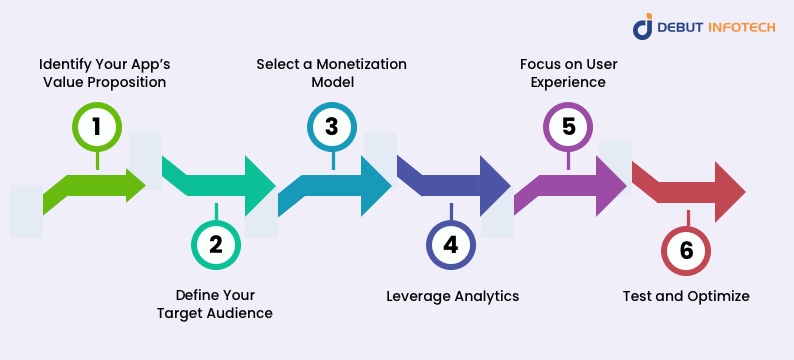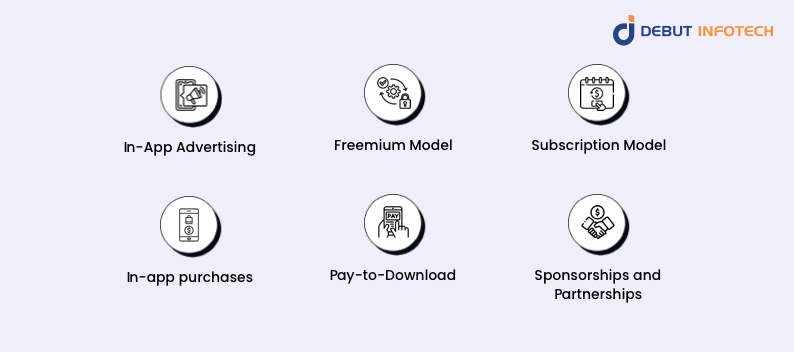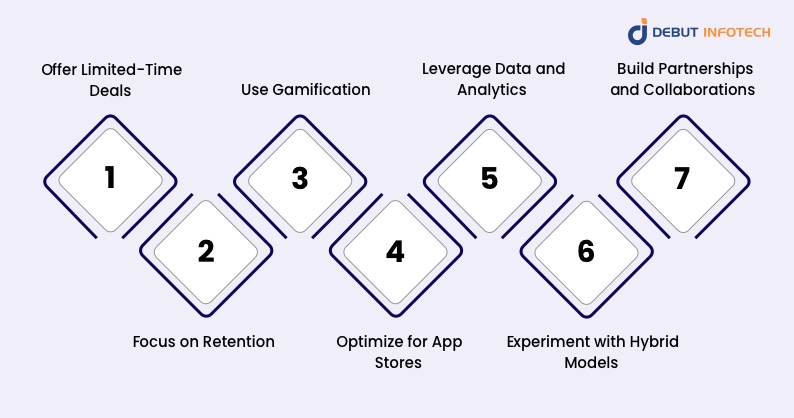Table of Contents
Home / Blog / Mobile Development
Mobile Apps Monetization Strategies: How to Make Your App Profitable
January 29, 2025

January 29, 2025
Mobile apps have become essential tools for businesses in all fields in today’s fast-paced digital world. However, developing a mobile app is only the first step. App developers and companies have to investigate sustainable income sources if they want to guarantee long-term success. This is where mobile app monetization comes in. Monetising a mobile app means coming up with ways to make money from it so that it not only provides value to its users but also helps the business make money. Whether you run an established company looking to maximise income sources or a startup introducing its first app, understanding the technical aspects of mobile app monetization is vital.
Working with companies to turn ideas into profitable digital solutions, Debut Infotech has been leading in the development of mobile apps. Along with the tools and techniques used to create income, the evolution of the app development process over the years has witnessed tremendous growth. This article will go over several approaches to making money from mobile apps—in-app purchases, subscription models, adverts, and more. We will also discuss the several mobile app development frameworks and how they affect your monetizing plan. This enables you to design a profitable app appropriate to your company’s objectives.
Turn your app into a profit-generating machine!
Let us help you implement the best mobile app monetization strategies.
What is Mobile App Monetization?
Mobile app monetization is the income-generating process associated with a mobile application. Many models—including advertising, in-app sales, subscription programs, sponsorships, or even a paid download fee—could help to accomplish this. A well-considered monetizing plan guarantees that an app not only covers running expenses but also starts to be a consistent source of income for companies.
The target demographic of your app, speciality, and market needs will mostly determine how successful your monetizing plan is. Gaming apps, for example, frequently rely on in-app purchases, whereas news or streaming apps typically live on subscription models. Being a top mobile app development firm, we know how important it is to generate income without sacrificing user experience by smoothly including monetizing techniques in the app development process.
How to Monetize a Mobile App

To make money from a mobile app, you need to know what it’s for, who it’s meant for, and what value it provides. These fundamental guidelines will enable you to create a profitable monetizing strategy:
- Identify Your App’s Value Proposition: Why is your application special? Determining the most effective monetization technique for your app requires evaluating its primary value, which could be fixing a problem, offering entertainment, or offering convenience.
- Define Your Target Audience: Your monetizing model will also be much influenced by the demographics, tastes, and expenditure patterns of your audience. Younger viewers might respond better to gamified in-app purchases, for instance, while professionals would want subscription-based solutions.
- Select a Monetization Model: Different apps call for different revenue sources. A game software might excel on in-app purchases, for example, whereas a streaming platform might gain from a subscription approach. A few sections down, we’ll talk about the most common monetization models.
- Leverage Analytics: Analytics tools let you better focus your mobile app monetizing strategy by revealing insights into user behaviour. Optimization strategies for making money can benefit greatly from looking at metrics like retention rate, session length, and user demographics.
- Focus on User Experience: Avoid sacrificing user experience for financial gain at any cost. Make sure any premium features, purchases, or adverts smoothly fit and don’t compromise usability.
- Test and Optimize: Successful monetization requires ongoing attention. Refine your strategy and guarantee long-term profitability by means of regular testing, user comments, and statistics.
Popular In-App Monetization Models

Making your mobile app lucrative mostly depends on selecting the appropriate in-app monetizing strategy. Every model has special advantages, and drawbacks, and is fit for particular kinds of apps and users. Let’s examine closely the most successful mobile app monetization strategies now in use.
1. In-App Advertising
One often utilized and simple approach to generate income is in-app advertising. Ads displayed inside your app allow you to collect money depending on impressions, clicks, or other user activities. Achieving a balance between making money and improving the user experience is important for this plan to work. Badly executed commercials can cause usability to be disrupted, which would cause discontent and high loss rates.
Here are the most common types of in-app ads:
- Banner Ads: These are positioned either at the top or bottom of the screen. Although non-intrusive, occasionally they blend into the UI and reduced engagement rates result.
- Interstitial Ads: Full-screen adverts called interstitial ads show up during transitions—between game levels or following task completion. Though they provide better visibility, they should only be used rarely to avoid irritating consumers.
- Rewarded Ads: These ads provide users the chance to earn in-app benefits like coins, lives, or premium features by willingly watching videos or interacting with them. Because they motivate user involvement without being invasive, rewarded adverts are quite successful.
Analytics and audience segmentation help you to customize the kinds and frequency of advertising to maximize income while maintaining people’s interest.
2. Freemium Model
Among the most often used mobile app monetization techniques are freemium models. Users of this method can download and use the app for free but must pay to get additional capabilities, content, or functionality.
This model works well for apps that do basic things but have extra features or tools that users would be happy to pay for. As an example:
- A productivity app may offer basic task management for free but requires a subscription to access features like team collaboration or data syncing.
- A gaming app could allow users to play for free while offering paid upgrades like new levels, exclusive characters, or power-ups.
The freemium model’s success hinges on clearly separating free from premium services and making sure free consumers still enjoy their experience. Using this approach, apps sometimes depend on upselling strategies to gradually turn free users into paying consumers.
3. Subscription Model
One of the most profitable approaches to monetize apps is the subscription model. It creates a regular, steady income for the owners. Paying a fee weekly, monthly, or yearly gives users access to premium material or services.
This approach works wonders for programs that provide continuous value, like:
- Streaming Apps: Platforms like Netflix and Spotify charge subscriptions for unlimited access to their libraries of movies, shows, or music.
- Fitness Apps: Apps like Peloton or MyFitnessPal provide workout plans, live classes, or personalized coaching to subscribers.
- Productivity Tools: Applications like Notion or Evernote charge for advanced organizational features, integrations, and cloud storage.
Offering premium, constantly updated materials or features that support the membership pricing will help one succeed with this strategy. Providing a free trial time can also inspire consumers to see the worth of the app before making a subscription plan commitment.
4. In-app purchases
Another well-liked mobile app monetization model is in-app purchases. This approach lets users purchase either actual or virtual items from within the app. This model works well across various app categories, including games, e-commerce, and lifestyle apps.
Examples include:
- Gaming Apps: Players of gaming apps can buy virtual money, characters, weapons, or cosmetics including skins and costumes. For instance, games like Fortnite have generated billions through in-app purchases alone.
- E-Commerce Apps: Retailers like Amazon or Etsy enable users to shop for products directly through their apps.
- Lifestyle Apps: Apps like Calm or Headspace may offer users the ability to purchase specific meditation packs or courses individually.
Designing attractive, worthwhile products that improve user experience will help you increase income from in-app sales. Since any difficulty or uncertainty could discourage consumers from making transactions, developers should also guarantee that the purchasing process is flawless and safe.
5. Pay-to-Download
Users of the pay-to-download model must pay an upfront cost to get the app. This model isn’t used as often because of all the free apps out there, but it can still work for niche or high-value apps.
For example:
- Niche productivity apps that solve specific problems for professionals (e.g., advanced design or editing tools).
- Educational apps that provide premium courses or learning materials.
- Superior mobile games with unique, original graphics or gameplay mechanics.
Although the pay-to-download approach can generate quick money, its success usually depends on good marketing and a convincing value proposition. Providing a free trial or demo edition will encourage downloads since users are less ready to pay ahead without first seeing the advantages of the app.
6. Sponsorships and Partnerships
Collaborating with companies or organizations to showcase their products, services, or information within your app is what sponsorships and partnerships are all about. Applications with a niche audience that fits the sponsor’s target market will find this strategy very successful.
Examples of sponsorships include:
- A fitness app partnering with a sportswear brand to feature exclusive promotions or sponsored challenges.
- A travel app promoting hotel deals or discounts from a specific chain.
- A news app collaborating with media outlets to deliver exclusive sponsored content.
The app makes money, the sponsor gets exposure, and users get pertinent promotions or material, therefore benefiting all those engaged. To make this approach work, you need to make sure that sponsorships don’t get in the way of your app’s main purpose or the user experience.
Effective Ways to Monetize Your App

Apart from selecting the appropriate income model, here are some further ideas for maximizing mobile app monetization:
1. Offer Limited-Time Deals
Using discounts, limited-time deals, or bundled packages, inspire consumers to make in-app purchases or subscriptions. These strategies not only generate quick income but also assist in turning free users into paying consumers.
2. Focus on Retention
Getting new users costs money, so keep the ones you already have. Share frequent updates, fresh features, and incentives to keep users involved. Engaged users are more inclined to use premium features, buy in-app, or renew subscriptions, which guarantees a consistent flow of revenue.
3. Use Gamification
Gamification lets your software include a fun, competitive component that motivates users to spend more time and money. Leaderboards, challenges, and incentives, for example, greatly increase engagement.
4. Optimize for App Stores
Attracting new users depends on increasing the exposure of your app in app stores, which affects your income potential immediately. Focus on App Store Optimization (ASO) by:
- Use relevant keywords like “mobile app monetization” or “how to monetize mobile app” in your app title and description.
- Writing an engaging app description that highlights unique features and benefits.
- Including high-quality screenshots and videos to showcase the app’s functionality.
- Promoting good ratings and reviews will help your app to be more credible and rank higher.
If your app’s visibility in the app store is maximized, more people will see it, which means more downloads and more chances to make money.
5. Leverage Data and Analytics
Perfecting your monetizing plan depends on closely examining user data. Examining user behaviour, preferences, and engagement patterns helps you to find highly successful items or features to highlight going forward.
- Determine where consumers are losing interest in your app and fix their problems.
- Divide your audience to generate customized offers or focused campaigns.
Simplifying the payment flow will assist increase in-app purchase conversions, for instance, if analytics show users often leaving the app during the checkout process.
6. Experiment with Hybrid Models
To diversify income sources, think about combining several models instead of depending just on one cash stream. For instance:
- Offer a freemium edition with advertisements, then give paying users an ad-free experience.
- Include in-app purchases alongside a subscription model for users who prefer one-time payments over recurring ones.
A hybrid approach allows you to cater to a wider audience while maximizing your earning potential.
7. Build Partnerships and Collaborations
Working with different companies or brands can open fresh revenue sources. For instance:
- Collaborate with companies to offer exclusive discounts or co-branded products.
- Feature sponsored content or promotions within your app.
This strategy performs very effectively for niche apps with a committed audience fit for the sponsor’s target market.
Combining these approaches with a robust mobile app development process will help you to guarantee that your app not only draws users but also generates constant and scalable income.
The Role of Mobile App Development in Monetization
Making sure your app is monetizing from the beginning depends on selecting an appropriate mobile app development company. From choosing appropriate mobile app development frameworks to using flawless payment channels, every stage of the app development process contributes to defining the profitability of your app.
Our area of expertise at Debut Infotech is designing not only aesthetically pleasing apps but also working apps that have strong monetizing capabilities. Understanding your target demographic and industry trends helps you maximize income potential and decrease mobile app development cost.
Why Choose Debut Infotech for Your Mobile App Development Needs?
Being among the top mobile software companies, we have a lot of knowledge of developing apps for many different sectors. Our team of experts guarantees that, by using efficient mobile app monetization techniques, your app can give users a flawless experience and sit in tune with your company’s objectives.
Whether your company is a startup or an established one, our knowledge of mobile app development frameworks and creative ideas affirms that your app will stand out in the competitive mobile app development marketplace.
Ready to monetize your app effectively?
Contact us today to explore proven strategies for maximizing your app’s revenue potential!
Conclusion
If you want your mobile app to be a successful business, you need to learn how to monetize it. From knowing your target to choosing the correct income source, every choice affects the financial viability of your app. Your app can recoup its mobile app development cost and generate a sustained income stream with the correct strategy.
When it comes to developing and monetizing mobile apps, Debut Infotech is here to help businesses through the maze.
Frequently Asked Questions
Monetizing a mobile app is the process of making money off of one. It is crucial since it guarantees that your software recovers development expenses, stays financially sustainable, and generates a consistent income to support upgrades, new features, and company expansion.
Some of the most popular models include:
1. In-app advertising (banner, interstitial, and rewarded ads).
2. Freemium model (free download with paid premium features).
3. Subscription-based model (recurring payments for premium content).
4. In-app purchases (buying virtual or physical goods).
5. Pay-to-download (upfront payment to access the app).
6. Sponsorships and partnerships.
The best monetization model depends on your app’s category, target audience, and purpose. For example:
1. If your app is a game, in-app purchases and rewarded ads work well.
2. Subscription models are great for streaming, fitness, or productivity apps.
3. Freemium is effective if you have a large user base willing to pay for advanced features.
Combining multiple models can also diversify your revenue streams.
Absolutely! Free apps are often monetized through in-app advertising, freemium models, in-app purchases, and sponsorships. These strategies allow you to attract a large user base without charging upfront while still earning revenue from their engagement.
The cost of mobile app development varies depending on the app’s complexity, features, and platform (iOS, Android, or both). While development costs can range from $20,000 to $200,000 or more, an effective monetization strategy can help you recover these costs and ensure profitability in the long term. Working with a reliable mobile app development company can help you optimize both costs and revenue potential.
User experience is critical for successful monetization. Intrusive ads, poorly designed in-app purchase flows, or excessive paywalls can frustrate users and lead to high churn rates. A seamless, user-friendly experience ensures that monetization strategies, like ads or purchases, feel natural and do not disrupt app usage.
Key metrics to track include:
1. Revenue per user (ARPU): Average revenue generated per active user.
2. Retention rate: Percentage of users who continue using your app over time.
3. Conversion rate: Percentage of users who make purchases or subscribe.
4. Engagement: How often and for how long do users interact with your app?
Analyzing these metrics using analytics tools will help you optimize your monetization strategy for better results.
Talk With Our Expert
Our Latest Insights
USA
2102 Linden LN, Palatine, IL 60067
+1-703-537-5009
[email protected]
UK
Debut Infotech Pvt Ltd
7 Pound Close, Yarnton, Oxfordshire, OX51QG
+44-770-304-0079
[email protected]
Canada
Debut Infotech Pvt Ltd
326 Parkvale Drive, Kitchener, ON N2R1Y7
+1-703-537-5009
[email protected]
INDIA
Debut Infotech Pvt Ltd
C-204, Ground floor, Industrial Area Phase 8B, Mohali, PB 160055
9888402396
[email protected]




Leave a Comment